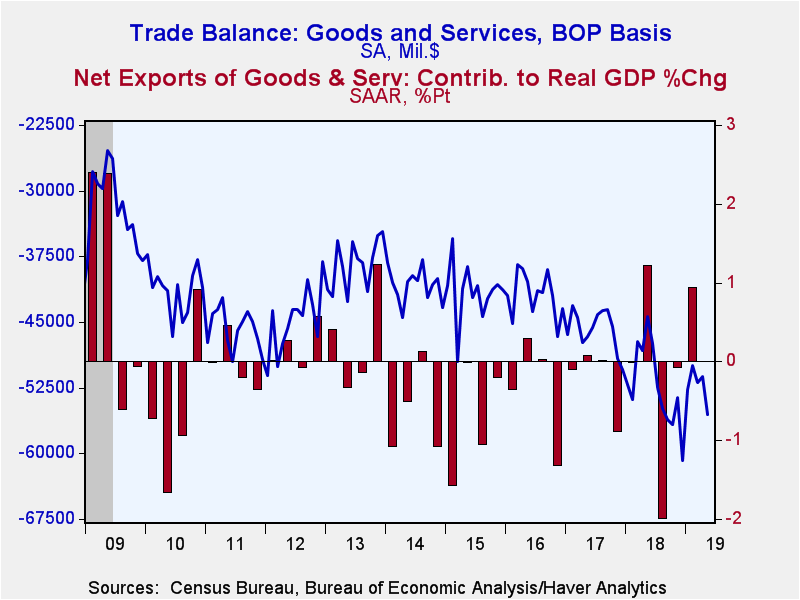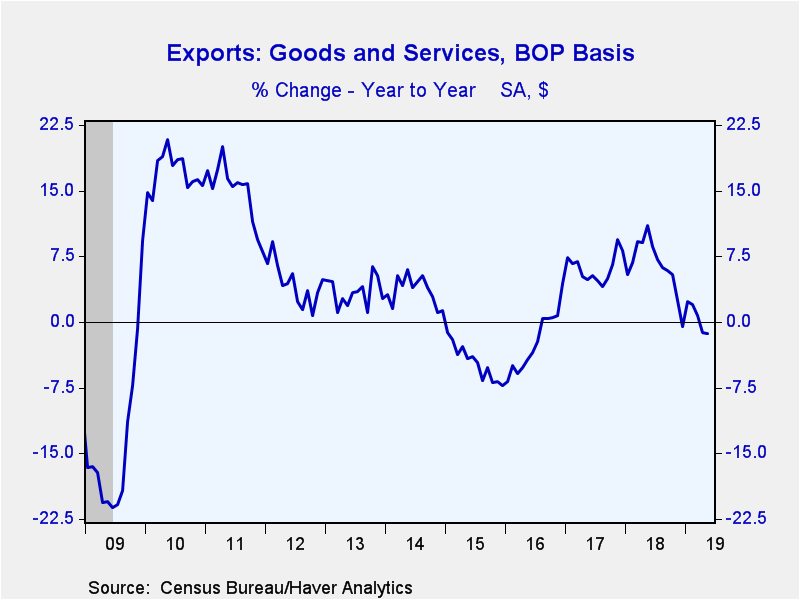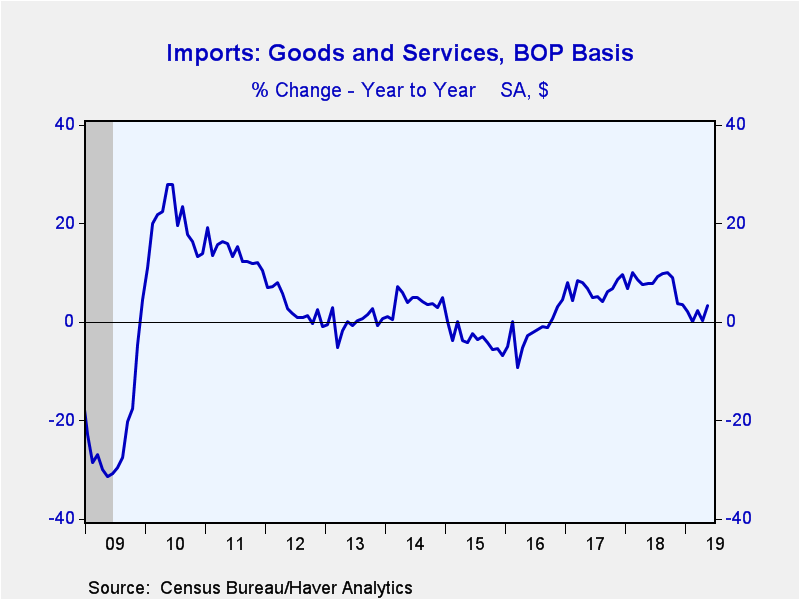 Global| Jul 03 2019
Global| Jul 03 2019U.S. Trade Deficit Widens More Than Expected in May
by:Sandy Batten
|in:Economy in Brief
Summary
The U.S. trade deficit in goods and services widened more than expected in May to $55.5 billion from an upwardly revised $51.2 billion in April (originally $50.8 billion). The consensus expectation from the Action Economics Survey was [...]
The U.S. trade deficit in goods and services widened more than expected in May to $55.5 billion from an upwardly revised $51.2 billion in April (originally $50.8 billion). The consensus expectation from the Action Economics Survey was for a $53.5 billion deficit. The $4.3 billion widening of the goods and services deficit was larger than the $3.6 billion widening in the goods deficit reported in the advance trade report released on June 26. Exports rebounded in May, rising 2.0% m/m (-1.3% y/y) after a downwardly revised 2.4% m/m decline in April. Imports jumped up 3.3% m/m (3.3% y/y) following an unrevised 2.2% m/m fall in April. The goods deficit widened markedly to $76.1 billion in May from $71.7 billion while the services surplus widened only slightly to $20.6 billion from $20.5 billion. Year to date, the goods and services deficit totaled $261.4 billion in May, up sharply from $245.7 billion in the first five months of 2018.
The real trade deficit in goods (that is, adjusted for price changes) also widened considerably in May after having narrowed slightly in April. For the two months of Q2, the real goods deficit is on course to widen by around $6 billion (in 2012$) which would subtract between 0.1%-pt and 0.2%-pt from overall real GDP growth in Q2, a stark contrast to the 0.94%-pt addition in Q1.
Goods exports rose 2.9% m/m in May, almost offsetting the 3.2% m/m decline in April. This was the strongest monthly gain since May 2018. The may increase was widely spread across end-use categories with only exports of industrial supplies and materials experiencing a decline. Exports of foods and feeds rose 6.5% m/m, their third consecutive monthly increase, to lead the overall increase. Exports of automotive vehicles and parts jumped 4.8% m/m, and exports of consumer goods excluding autos also posted a solid 4.7% m/m gain in May.
Imports of goods climbed 3.9% m/m in May, more than offsetting their 2.5% m/m drop in April. Again, the gains were widespread across end-use categories with only imports of foods and feeds experiencing a monthly decline. The overall monthly increase was led by a 7.5% m/m jump in imports of automotive vehicles and parts followed by a 4.0% m/m increase in imports of industrial supplies and materials.
The relative importance of autos in the monthly increases in both goods exports and goods imports likely partially reflects the rushing of autos and parts into and out of Mexico as President Trump in early May threatened to impose tariffs on Mexican trade unless Mexico took a much more active role in controlling the flow of immigrants across the US-Mexico border.
Petroleum imports surged 9.2% m/m in May following a 4.2% m/m rise in April. This was the fourth consecutive monthly increase following five consecutive monthly declines. After adjusting for changes in petroleum prices, real petroleum imports rose 8.8% m/m in May after a 1.8% m/m decline in April. The price of crude oil imports rose 5.9% m/m in May, the fourth consecutive monthly increase, to $60.56 per barrel, its highest price in seven months. Non-petroleum imports rose 3.4% m/m in May, offsetting a 3.1% m/m decline in April.
Services exports rose 0.5% m/m in May following a 0.9% m/m drop in April. The rise was relatively widespread, led by a 3.3% m/m increase in maintenance and repair services. Services imports also rose 0.5% m/m in May after a 0.7% m/m decline in April. The May gain was led by a 2.5% m/m rise in transport service imports. Travel imports declined 0.6% m/m in May.
The seasonally adjusted trade deficit with China widened to $30.1 billion in May from $29.4 billion in April. For the first five months of this year, the deficit with China totaled $150.2 billion, down from $167.1 billion in the first five months of 2018. Exports to China jumped 15.3% m/m in May after having collapsed 17.1% m/m in April. Imports from China rose 5.2% m/m in May versus 0.9% m/m in April.
The international trade data as well as oil prices can be found in Haver's USECON database. Detailed figures on international trade are available in the USINT database. The expectations figures are from the Action Economics Forecast Survey, which is carried in AS1REPNA.
| Foreign Trade in Goods & Services (Current $) | May | Apr | Mar | May Y/Y | 2018 | 2017 | 2016 |
|---|---|---|---|---|---|---|---|
| U.S. Trade Deficit ($ bil.) | 55.5 | 51.2 | 51.9 | 44.4 (5/18) |
627.7 | 550.1 | 503.0 |
| Exports of Goods & Services (% Chg) | 2.0 | -2.4 | 0.8 | -1.3 | 6.3 | 6.2 | -2.2 |
| Imports of Goods & Services (% Chg) | 3.3 | -2.2 | 1.4 | 3.3 | 7.8 | 6.8 | -1.7 |
| Petroleum (% Chg) | 9.2 | 4.2 | 11.4 | 2.1 | 20.8 | 27.2 | -19.5 |
| Nonpetroleum Goods (% Chg) | 3.4 | -3.1 | 0.9 | 2.8 | 7.5 | 5.5 | -1.2 |
Sandy Batten
AuthorMore in Author Profile »Sandy Batten has more than 30 years of experience analyzing industrial economies and financial markets and a wide range of experience across the financial services sector, government, and academia. Before joining Haver Analytics, Sandy was a Vice President and Senior Economist at Citibank; Senior Credit Market Analyst at CDC Investment Management, Managing Director at Bear Stearns, and Executive Director at JPMorgan. In 2008, Sandy was named the most accurate US forecaster by the National Association for Business Economics. He is a member of the New York Forecasters Club, NABE, and the American Economic Association. Prior to his time in the financial services sector, Sandy was a Research Officer at the Federal Reserve Bank of St. Louis, Senior Staff Economist on the President’s Council of Economic Advisors, Deputy Assistant Secretary for Economic Policy at the US Treasury, and Economist at the International Monetary Fund. Sandy has taught economics at St. Louis University, Denison University, and Muskingun College. He has published numerous peer-reviewed articles in a wide range of academic publications. He has a B.A. in economics from the University of Richmond and a M.A. and Ph.D. in economics from The Ohio State University.










